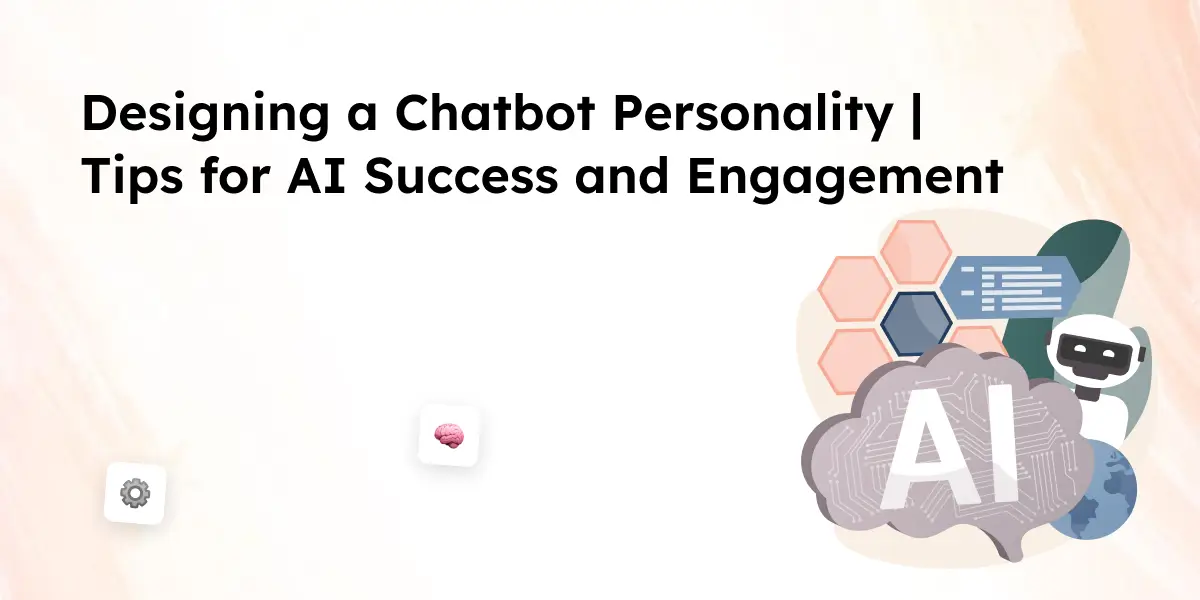A chatbot with a distinct personality enhances customer experience, strengthens brand identity, and boosts engagement. Without one, chatbots can feel robotic and unrelatable. Whether for customer support or sales, adding personality makes chatbot conversations more human-like and meaningful.
This guide covers how to design a chatbot personality using AI technology, natural language processing, and machine learning. By the end, you’ll know how to create a chatbot that provides a tailored, engaging experience for your target audience.
What is a Chatbot Persona?
A chatbot persona defines the bot’s personality, tone, and behavior. It shapes how users perceive and interact with the chatbot, making the experience more engaging and human-like. Chatbots are designed to respond to inquiries, but without a defined personality, they may feel generic and impersonal.
When creating a chatbot for your business, it’s important to tailor its personality to match your brand identity and target audience. Consider the following factors:
- Brand identity: A chatbot should reflect your brand’s voice and values.
- Target audience: The bot’s personality should align with your users’ preferences.
- Tone and style: A casual and friendly chatbot works for eCommerce, while a formal and professional chatbot suits financial services.
Chatbots with distinct personalities improve customer engagement by building an emotional connection with users. Depending on your industry and goals, you might want to choose a chatbot personality that is:
- Humorous: Adds a fun and lighthearted touch to interactions.
- Professional: Ideal for businesses that require trust and authority.
- Empathetic: Helps users feel understood and supported, especially in customer support.
A good example is ChatGPT, which adapts its conversational design based on user input. AI development allows chatbots to use natural language processing and machine learning to refine their responses over time, ensuring a better user experience based on user feedback.
Why Your Chatbot Needs a Personality
A chatbot’s personality is more than just a creative addition—it plays a major role in how users interact with and perceive your brand. Whether your chatbot is handling customer support, sales, or general inquiries, adding personality helps make interactions feel more human-like and engaging.
1. Enhances Customer Engagement
A chatbot that feels robotic can make conversations dull and frustrating. Giving your bot a personality helps:
- Make interactions feel more natural and conversational
- Encourage users to continue engaging with the chatbot
- Build an emotional connection between customers and your brand
2. Strengthens Brand Identity
Your chatbot’s tone and communication style should align with your brand’s personality. Whether your brand identity is casual and friendly or formal and professional, your chatbot’s personality should reflect that.
For example:
- A playful and witty chatbot might work for a lifestyle brand
- A polite and informative chatbot could be ideal for financial services
- A relatable and engaging chatbot works well for customer-focused industries
3. Improves Customer Experience
A chatbot that provides quick, relevant, and friendly responses enhances the customer experience. AI-powered chatbots with natural language processing and machine learning can:
- Understand user feedback and refine responses over time
- Offer personalized suggestions based on customer data
- Create more meaningful and contextual interactions
4. Builds Trust and Reliability
Customers are more likely to trust a chatbot that provides accurate, helpful responses. A bot’s personality can make a chatbot feel more dependable by:
- Maintaining a consistent and well-defined voice and tone
- Offering responses that align with brand values and customer expectations
- Adapting to different user needs while remaining professional and approachable
5. Makes Chatbot Conversations More Engaging
A chatbot with a distinct personality makes conversations more dynamic and enjoyable. Instead of feeling like they’re talking to a machine, users feel like they’re having a real conversation. Chatbots with distinct personalities help businesses stand out and improve the overall chatbot experience.
By defining AI chatbot personalities, companies can bridge the gap between automation and real human interactions. A chatbot built with a strong personality creates a better experience for everyone and ensures that interacting with a chatbot feels natural and engaging.
How to Create a Chatbot Persona (Step-by-Step)
Creating a chatbot for your business goes beyond setting up automated responses. A well-designed chatbot persona helps users connect with the bot, improving customer engagement and overall experience. Below is a step-by-step approach to designing a chatbot personality that aligns with your brand identity and user expectations.
1. Define the Role and Use Case of Your Chatbot
Before choosing a bot personality, identify its purpose. Chatbots can help in various industries, and their personality should match their primary function.
- Customer support bots should be empathetic and reliable
- Sales chatbots might be persuasive and engaging
- Educational chatbots should be informative yet approachable
- Entertainment bots can be playful and humorous
The chatbot use case determines whether your chatbot needs to be formal and professional or casual and friendly.
2. Align with Your Brand’s Tone and Voice
A chatbot’s tone should match your brand’s communication style. Ask yourself:
- Should your chatbot be formal, neutral, or friendly?
- Does it need to use emojis, humor, or a professional tone?
- How should it handle customer frustrations or complaints?
Make sure your chatbot’s voice and tone reflect the experience you want your customers to have. Brands that offer chatbots with consistent personalities create a more seamless chatbot experience.
3. Add Personality Traits to Your Chatbot
A chatbot’s personality might be defined by specific traits that make it unique. Consider the following:
- Choose one personality type that matches your audience, such as friendly, authoritative, or playful
- Giving your bot a name and backstory can make it more relatable
- Decide how your chatbot responds to different emotions, such as excitement or frustration
Adding personality makes chatbot conversations feel more human-like, improving user engagement and making interactions more enjoyable.
4. Use AI-Powered Features to Improve Responses
AI development allows chatbots to evolve using natural language processing and machine learning. AI chatbots powered by generative AI can:
- Learn from customer data to improve interactions
- Adjust responses based on user feedback
- Provide a chatbot experience that feels personalized and engaging
AI technology helps chatbots respond in a more natural, contextual way, bridging the gap between automation and human interaction.
5. Test and Refine Based on User Feedback
A chatbot’s personality should not be static. Based on user feedback, refine how the chatbot works to better meet customer needs. Consider:
- Adjusting tone and responses based on conversations
- Monitoring frequently asked questions and improving answers
- Using customer engagement data to enhance personalization
A chatbot built with a strong, consistent personality makes the experience more engaging for users while improving brand perception. The key is to ensure the bot’s personality stays relevant and evolves with changing user expectations.
Best Practices for an Engaging Chatbot Personality
Creating a chatbot with a distinct personality helps improve customer engagement and user experience. However, to make a chatbot truly effective, it needs to feel human-like while staying aligned with brand identity and customer expectations. Here are the best practices to ensure a chatbot’s personality enhances interactions.
1. Keep the Chatbot’s Tone Consistent
A chatbot’s tone should match the brand’s voice and stay consistent across all interactions. Whether a chatbot is casual and friendly or formal and professional, its responses should always align with its defined personality.
- A playful chatbot should maintain a lighthearted tone in all conversations
- A professional chatbot should remain informative and respectful
- A customer support chatbot should always be empathetic and helpful
Consistency makes the chatbot more reliable and ensures a seamless chatbot experience.
2. Make the Chatbot Conversational
Chatbots can also improve engagement by feeling more natural in conversations. Using natural language processing, AI-powered bots can:
- Avoid robotic, overly scripted replies
- Adapt to different user inputs to provide relevant responses
- Use contextual language to make interactions feel more dynamic
Conversational design helps bridge the gap between automation and real human interactions, making chatbot conversations feel more engaging.
3. Personalize the Experience for Users
A chatbot that provides a tailored experience makes users feel more valued. By leveraging customer data and AI technology, chatbots can:
- Adjust responses based on user preferences
- Offer personalized recommendations and answers
- Create a chatbot experience that feels relevant and meaningful
Personalization improves customer engagement and ensures the chatbot works effectively across different scenarios.
4. Handle Frequently Asked Questions Effectively
A well-designed chatbot should be able to respond to inquiries with clarity and efficiency. By organizing responses to frequently asked questions, chatbots can:
- Provide instant, helpful answers to common issues
- Reduce frustration by guiding users to the right information
- Learn from past interactions to improve future responses
A chatbot built for customer support should focus on making information accessible and easy to understand.
5. Balance Automation with Human-Like Characteristics
Chatbots should feel more human while still being efficient. To make interactions engaging:
- Use friendly personality traits to make the chatbot relatable
- Keep responses natural and conversational
- Allow easy access to human support when needed
A chatbot that provides the right mix of automation and human-like characteristics improves customer satisfaction and builds trust in the brand.
By following these best practices, businesses can design a chatbot personality that enhances customer engagement, makes interactions smoother, and ensures a positive user experience.
Mistakes to Avoid When Creating a Chatbot for Your Business
Designing a chatbot for your business requires careful planning. A chatbot could enhance customer engagement, but if not designed well, it can frustrate users and harm the brand experience. Here are common mistakes businesses should avoid when building a chatbot with a distinct personality.
1. Overcomplicating the Chatbot’s Responses
A chatbot should be easy to understand and interact with. Common mistakes include:
- Using overly complex language instead of natural language processing for clear responses
- Providing too much information in a single message, overwhelming the user
- Not keeping answers concise, making chatbot conversations feel long and confusing
A well-designed chatbot experience should prioritize simplicity and clarity.
2. Ignoring User Feedback
Chatbots should improve over time based on user feedback. Businesses that ignore feedback risk making their bot feel outdated and ineffective. Instead:
- Monitor chatbot interactions to identify where users struggle
- Update chatbot responses based on frequently asked questions
- Ensure the chatbot’s tone remains consistent while refining its responses
Regular improvements ensure that interacting with a chatbot remains useful and engaging.
3. Failing to Personalize the Chatbot Experience
A chatbot that provides generic responses can feel robotic and disconnected. AI-powered personalization makes the chatbot experience more engaging by:
- Using customer data to tailor responses
- Recognizing returning users and adapting to their preferences
- Offering recommendations based on past interactions
Adding personality to a chatbot improves customer engagement and builds a stronger emotional connection with users.
4. Not Defining the Chatbot’s Personality Clearly
Without a well-defined personality, a chatbot might feel inconsistent. A chatbot’s personality should be:
- Aligned with the brand’s voice and identity
- Consistent in how it communicates across different scenarios
- Designed to respond in a way that suits the chatbot use case
Businesses should define AI chatbot personalities early in development to avoid inconsistencies in user interactions.
5. Not Offering an Option to Connect with a Human
Even the best chatbots can’t handle every situation. A chatbot that doesn’t provide an easy way to escalate issues to human support can frustrate users. To avoid this mistake:
- Make sure your chatbot’s responses include an option for live chat if needed
- Use AI agents to recognize when a user needs human intervention
- Balance automation with a smooth transition to human support when necessary
6. Forgetting to Test and Optimize
A chatbot works best when continuously tested and improved. Businesses that launch a chatbot without testing can face:
- Technical issues that disrupt chatbot conversations
- Poor user experience due to unclear or irrelevant responses
- A chatbot’s personality feeling inconsistent or unnatural
Testing ensures the chatbot experience remains high-quality and aligned with user needs.
By avoiding these mistakes, businesses can create a chatbot that enhances customer engagement, strengthens brand identity, and makes chatbot interactions more meaningful.
Conclusion
A chatbot personality is essential for improving user engagement and customer experience. A well-defined chatbot persona strengthens brand identity, makes conversations more human-like, and enhances personalization. Businesses should focus on conversational design, AI technology, and user feedback to ensure their chatbot works effectively. By adding personality and tailoring interactions, chatbots can provide a more dynamic and engaging experience that resonates with users.
FAQs
1. How do AI chatbots improve customer engagement?
AI chatbots use natural language processing and machine learning to provide relevant responses in real time. By tailoring interactions based on customer data and past conversations, chatbots can:
Answer inquiries quickly and accurately
Provide a more personalized chatbot experience
Keep users engaged with dynamic and conversational responses
2. What’s the difference between a chatbot persona and a regular chatbot?
A chatbot persona includes personality traits, tone, and conversational style, making the chatbot more relatable and engaging. A regular chatbot, on the other hand, simply provides automated responses without a defined personality. Chatbots with distinct personalities feel more human-like and enhance customer experience.
3. How do I ensure my chatbot remains helpful and not annoying?
To keep a chatbot effective and user-friendly:
Avoid overly long or robotic responses
Ensure chatbot conversations stay relevant and to the point
Allow users to opt out or request human support when needed
Update responses based on user feedback and frequently asked questions



